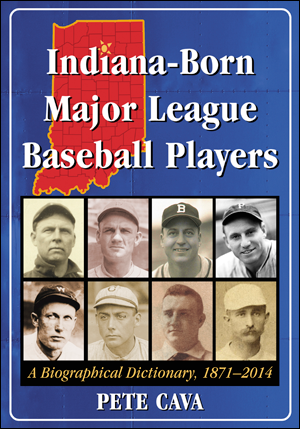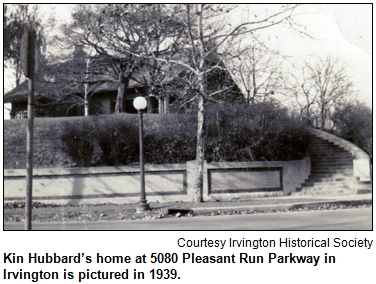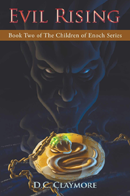Saturdays, noon to 1 p.m. ET on WICR 88.7 FM.
Or listen live from anywhere on WICR
Online!
May 2 show
Abe Martin's creator, Kin Hubbard
|
"You can take a voter to th' polls, but you can’t make him think."
"When a feller says, 'it hain't the money, but th' principle o' th' thing,' it's the money."
"Now an' then, an innocent man is sent to th' legislature."
 Do these quips sound as relevant today as they did a century ago? If so, that's testament to the talents of one of Indiana's best-known cartoonists - and the enduring appeal of his nationally syndicated character.
Do these quips sound as relevant today as they did a century ago? If so, that's testament to the talents of one of Indiana's best-known cartoonists - and the enduring appeal of his nationally syndicated character.
Abe Martin, the cracker-barrel philosopher who "lived" in Brown County, appeared in more than 300 newspapers across the country in the early 1900s. Will Rogers praised his creator, Indianapolis-based cartoonist Frank McKinney "Kin" Hubbard, as "America's greatest humorist" when he died.
 To explore the life and career of Kin Hubbard (1868-1930) - and the impact of his folksy Abe Martin character - Nelson will be joined in studio by Steve Barnett, executive director of the Irvington Historical Society.
To explore the life and career of Kin Hubbard (1868-1930) - and the impact of his folksy Abe Martin character - Nelson will be joined in studio by Steve Barnett, executive director of the Irvington Historical Society.
For most of the peak years of his career, Hubbard lived in the Irvington neighborhood on the eastside of Indy. A memorial to the cartoonist is at the corner of East New York Street and Emerson Avenue; at the memorial's dedication, Steve met Hubbard's son.
Hubbard placed his pipe-smoking, suspender-wearing Abe Martin character in Brown County in part because, during the early 1900s, the hilly, isolated county had one of the state's highest poverty and illiteracy rates. So the notion that a rustic Brown County resident could be a font of wisdom was considered humorous.
In the decades after the cartoonist's death, Brown County State Park dedicated a memorial to the cartoonist, and the rustic Abe Martin Lodge opened.
 Abe Martin made his first appearance in 1904 in The Indianapolis News, Hubbard's "home" newspaper. Hubbard was born in Bellefontaine, Ohio, and dropped out of school there before the seventh grade.
Abe Martin made his first appearance in 1904 in The Indianapolis News, Hubbard's "home" newspaper. Hubbard was born in Bellefontaine, Ohio, and dropped out of school there before the seventh grade.
More than 25 books of Abe Martin's witticisms eventually were published.
Hubbard's fans ranged from peers like Will Rogers to contemporary-era notables such as our guest Steve Barnett's former boss, the late Andy Jacobs. The longtime congressman from Indianapolis, who died in 2013, had an extensive collection of Abe Martin books and memorabilia.
A further sampling of Abe Martin quips:
"It's no disgrace to be poor, but it might as well be."
"We'd all like to vote fer th' best man, but he's never a candidate."
"T' err is human, but t' admit it haint."
Quips like those became so popular across the country that Kin Hubbard and his wife, Josephine, moved into a posh North Meridian Street mansion for the final year of his life - an ironic abode for the creator of a bumpkin character. In 1930, Hubbard died suddenly of a heart attack at the peak of his success at age 62.
Another irony: Hubbard had seen Brown County only once - during a brief train ride - in the first few years of the Abe Martin cartoon.
"He was in no rush to go again, for he had learned the natives thought he was making fun of them and did not always approve of the kind of characters he created," according to The Life and Times of Kin Hubbard by Fred C. Kelly (Farrar, Straus and Young, 1951). "A visit, he feared, might be embarrassing, even dangerous."
Fortunately, Brown County residents welcomed the cartoonist during his periodic road trips. Sadly, though, the Hubbards endured a tragedy during a car ride elsewhere in Indiana with their infant son, Kin Jr., in 1919. Their car broke down, slid down an embankment and plunged into a creek. The baby was pinned beneath the car and drowned.
Although the cartoonist was said to be affected forever by the tragedy, the output of his humor continued at a steady pace. By the time of his death, Hubbard had written more than 8,000 Abe Martin quips.
|
History Mystery
 A well-known quip -
"What this country needs is a really good five-cent cigar" - typically is attributed to a famous Hoosier political figure of the early 1900s. Many historians, though, believe the quip may have originated with Kin Hubbard's folksy Abe Martin character.
A well-known quip -
"What this country needs is a really good five-cent cigar" - typically is attributed to a famous Hoosier political figure of the early 1900s. Many historians, though, believe the quip may have originated with Kin Hubbard's folksy Abe Martin character.
The politician usually credited with the remark about five-cent cigars was known for his wit. He served as governor of Indiana before being elected to a national office. He died in 1925.
Question: Who was he?
The call-in phone number is (317) 788-3314, and please do not try to win the prize if you have won any prize from WICR during the past two months. Please do not call in to the show until Nelson has posed the question on the air.
The prize pack is a gift certificate to On Golden Pond at the Indiana Repertory Theatre and a gift certificate to Cadillac Ranch restaurant, courtesy of Visit Indy.
Roadtrip: Glory's road to Hope
|
Guest Roadtripper Glory-June Greiff tells us about the "surprising little town" of Hope, less than 50 miles southeast of Indianapolis on SR9 in northeastern Bartholomew County.
"The town square is charming, and only a few steps away is the Yellow Trail Museum , open weekends only," Glory tells us. "There are also several unusual shops on the square. Hungry? Try the Corner Café on the southwest corner of the square, one of those iconic small-town cafes with attached walkup ice cream stand. Or perhaps your tastes might run to Auntie Amiee's Country Tea Room on the north side of the square, open for lunch six days a week."
Preservationists will love the historic commercial buildings and residences; Hope was founded in 1830 by Moravians, and some pre-Civil War structures still survive. An 1837 cabin was moved from two miles east of town to a lot across SR9 from the Corner Cafe. Art and artisan enthusiasts will enjoy the Haw Creek Heritage Center, a branch of the Bartholomew County Historical Society. It's southeast of downtown at 111 Aiken Street, next to the fire station.
Your Hoosier History Live! team,
Nelson Price, host and
creative director
Molly Head, producer, (317)
927-9101
Richard Sullivan, webmaster
and tech director
Pam Fraizer, graphic
designer
Garry Chilluffo, media+development director
Please tell our sponsors that you appreciate their support: The Children of Enoch book series | Indiana Historical Society | Lucas Oil | Story Inn | Visit Indy

 Acknowledgments to Monomedia, Visit Indy, WICR-FM, Fraizer Designs, Heritage Photo & Research Services, Derrick Lowhorn and many other individuals and organizations. We are an independently produced program and are self-supporting through organizational sponsorships and individual contributions. We do not receive any government funding. Visit our website to learn how you can support us financially. Also, see our Twitter feed and our Facebook page for regular updates.
Acknowledgments to Monomedia, Visit Indy, WICR-FM, Fraizer Designs, Heritage Photo & Research Services, Derrick Lowhorn and many other individuals and organizations. We are an independently produced program and are self-supporting through organizational sponsorships and individual contributions. We do not receive any government funding. Visit our website to learn how you can support us financially. Also, see our Twitter feed and our Facebook page for regular updates.
May 9 show
Colorful Indiana-born baseball players
A Hoosier from Michigan City pitched the only "perfect game" in a World Series. Another major league baseball player from Indiana, a superstar for the New York Yankees, wore a number on his uniform (23) that symbolized a family tragedy.
And an obscure infielder from South Bend was the answer to a trivia question posed in the popular Peanuts comic strip by Charles Schulz.
 They are among the baseball figures whom we will explore when Nelson is joined by Indianapolis-based sports historian Pete Cava, the author of an upcoming, definitive book titled Indiana-Born Major League Baseball Players: A Biographical Dictionary, 1871-2014 (McFarland Publishing).
They are among the baseball figures whom we will explore when Nelson is joined by Indianapolis-based sports historian Pete Cava, the author of an upcoming, definitive book titled Indiana-Born Major League Baseball Players: A Biographical Dictionary, 1871-2014 (McFarland Publishing).
So many native Hoosiers have excelled in the major leagues (10 natives of Indiana are enshrined in the Baseball Hall of Fame in Cooperstown, N.Y.) that we can't cover all of the stars in a single show. Instead, we will focus on some of the most colorful anecdotes associated with pro baseball players during our program with Pete, who has had an extensive career writing about baseball and Olympic sports.
His new book, which will be published in the fall, includes an entry about Tommy John from Terre Haute, the former pitcher who underwent a pioneering type of elbow operation that ever since has been known by his name. "Tommy John surgery" has saved the careers of many pitchers, Pete notes.
The player whose uniform number symbolized a family tragedy was Evansville native Don Mattingly, who created a sensation with his stellar play as a Yankees first baseman during the 1980s.
Southern Indiana also was the home turf of a first baseman who Pete contends has been unfairly neglected by the Hall of Fame. Princeton native Gil Hodges (1924-1972) was a hard-hitting first baseman for the Brooklyn (and later Los Angeles) Dodgers. Then, Hodges managed the New York Mets to a shocking upset in the 1969 World Series. The team has gone down in history as the "Miracle Mets."
During the 1956 World Series, Michigan City native Don Larsen of the Yankees pitched a no-hitter (or "perfect game") that, to this day, is the only one in the history of the World Series.
So who inspired the Peanuts trivia question? A shortstop named Ollie Bejma (1907-1995), a South Bend native who captivated spectators in the 1930s on a short-lived major league team from St. Paul, Minn. More than 35 years later, he was saluted in Peanuts by Schulz, a Minnesota native.
Learn more:
© 2015 Hoosier History Live! All rights reserved.
Hoosier History Live!
P.O. Box 44393
Indianapolis, IN 46244
(317) 927-9101









